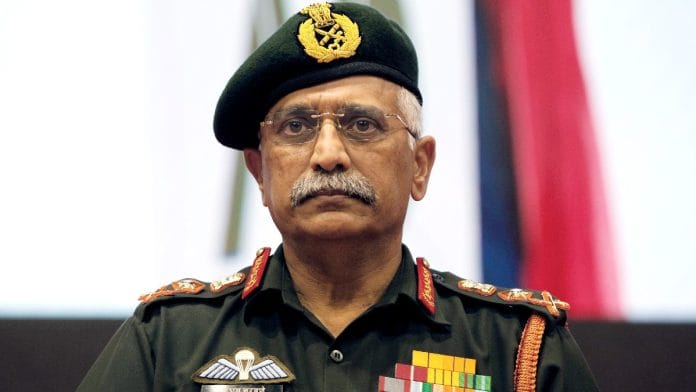New Delhi: Underscoring Tibet’s struggle for independence from China, former Army chief General Manoj Mukund Naravane (retd) said Wednesday that Tibetans world over have a legitimate right to return to the land of their forefathers and experience their culture and traditions.
He was speaking at the 6th International Rangzen (Independence) Conference at the India International Centre (IIC) in Delhi. Those in attendance included Geshe Lharampa Bawa Lobsang Pende, representative of the Tibetan Parliament in Exile, and Umit Hamit, a noted Uyghur freedom fighter.
According to Gen. Naravane, there are 60 lakh Tibetans in Tibet while 1,40,000 are in exile, of which 1,00,000 are in India. “This is an exceptional pool of latent power which needs to be harnessed,” he said.
He added: “It is indeed a historical fact that Tibet has been and is, the rightful neighbour of India and that the common border was open and peaceful, allowing not only free movement of trade and people, but also the flow of the finest thoughts of human civilisation.”
The former Army chief said that the principled Panchsheel Agreement — a treaty of five principles of coexistence signed by India and China in 1954 — especially the mutual non-interference clause, has resulted in an ambivalent policy over the Chinese occupation of Tibet. “Over the decades, China has fully occupied Tibet and made territorial and administrative changes that would transform the identity and culture of the Tibetans.”
Gen. Naravane went on to say that the latest white paper released by China claims that Tibet has been part of China since ancient times, i.e., from the 7th century AD onwards, which itself is “incorrect and an attempt to rewrite history”.
He suggested a two-pronged approach — ‘vertical integration’ and ‘horizontal stretch’ — that should be taken to help the Tibetan cause. Explaining the approach of ‘vertical integration’, he said that it will entail elevating these issues globally through multiple platforms, including the United Nations by engaging thought leaders and think tanks.
The ‘horizontal stretch’, he said, involves uniting people worldwide to sustain the momentum of the movement. “This approach should focus on creating a collective voice across the borders, ensuring that the Rangzen movement remains dynamic and impactful.”
Taking on China several times during the lecture, he compared the Chinese approach with that of India. He said, “Even though China has grown in strength, strength comes with its vulnerabilities. China operates with centricity of coercion and fear whereas India with centricity of cooperation and trust.”
He added that Chinese irredentism has been focused on Tibet, Taiwan, Xinjiang and even Mongolia. “It is also wise to recognise China’s Grey Zone actions which involve kinetic and non-kinetic forms of assertiveness, by resorting to selective historical referencing, cartographic manipulation and lawfare by leveraging its cyber and information domain capabilities.”
Also Read: ‘Did the Chinese beat you?’ A Tibetan writer has an answer to this old question in Dharamshala
‘Need to evolve a new Indo-Pacific architecture’
Speaking about the raising of villages in disputed territories by China, Gen. Naravane said that the construction of ‘Xiaokang’ (moderately prosperous) villages in disputed territories, announcement of the Land Border Law, and coercive exploitation of countries in the region, underscores the urgency for thorough examination and robust response.
He suggested that “to effectively counter” these actions, a coordinated approach involving “diplomatic, legal and international mechanisms is essential”. He added that there is a need to evolve a new Indo-Pacific architecture having the South Asian countries, including the financial hubs of Hong Kong and Taiwan, to control the hegemony of China.
He went on to say that major powers today appear willing to take on China, while the escalation of US-China contestation is intensifying with each passing day. “India today has emerged as a significant player at the global stage and will resolutely oppose Chinese attempts to unilaterally change the ‘status quo’. Post the Galwan incident, India has intensified the efforts to develop border infrastructure and rebalanced its military to thwart any nefarious Chinese designs,” he added.
The 2008 protests before the Beijing Olympics “exposed the Chinese propaganda of projecting a false image of prosperity and freedom in Tibet”, said Gen. Naravane. “It brought to the fore the courage and determination of Tibetans, and is indicative of the latent power of the people of Tibet.”
He added that the Chinese propaganda of development lay exposed, and the truth of repression was apparent. These protests conveyed to the world that the Tibet issue was alive even after decades of Chinese repression, he further said.
The former Army chief also called Tibet an ecological buffer as it relates to ecological security.
(Edited by Gitanjali Das)
Also Read: China’s G20 Srinagar game plan was hollow. PoK to Taiwan to Tibet, India can turn the table






